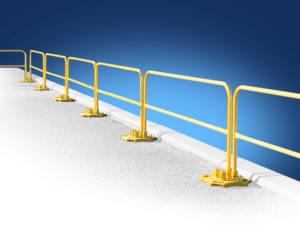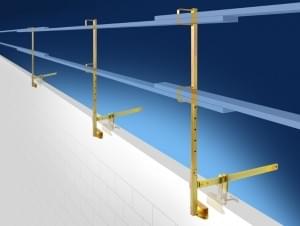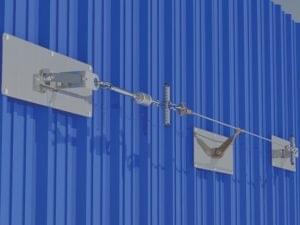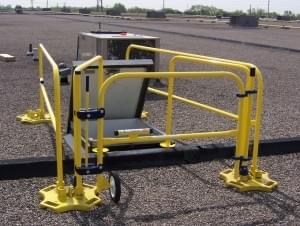The food and beverage industry is a massive market, both in the United States and across the globe. Food processing and packaging facilities, representing a large sector of this industry, struggle daily with protecting workers from safety hazards. And one huge concern safety managers in this industry deal with is providing adequate fall protection systems on our facilities’ rooftops when work and maintenance requires employees to go up on them. Installing a guard rail or life line system ensures that you and your workers stay safe at all times. Yet not all fall protection systems work in the same way, meaning that different roofs require different systems for maximum safety.
The variety of different options can be confusing to navigate — even for seasoned safety professionals. If you would like to increase your knowledge about the best type of protection system for your facility’s roof, keep reading. This article outlines four of the most common protection systems currently on the market, as well as the particular applications of each one.
 A guard rail is one of the simplest — yet most effective — ways to ensure rooftop safety in a food and beverage processing facility. As you likely already know, guard rails consist of fence-like structures erected around the leading edges of the roof. A competent company installs these systems long before the start of any work or maintenance on your roof. The sections of rails are anchored by flat, stable base plates that provide great stability without damaging rooftops.
A guard rail is one of the simplest — yet most effective — ways to ensure rooftop safety in a food and beverage processing facility. As you likely already know, guard rails consist of fence-like structures erected around the leading edges of the roof. A competent company installs these systems long before the start of any work or maintenance on your roof. The sections of rails are anchored by flat, stable base plates that provide great stability without damaging rooftops.
Building safety managers also have the option to install permanent guard rails, often referred to as mounted rail systems. These systems attach in one of two ways: either directly to the roof deck, or to the copings or outer edges of the roof deck. Rail systems whose mountings penetrate the roof deck will require the installation of flashing to prevent unwanted water intrusion.
Regardless of whether you choose a portable or permanent guard rail system, OSHA strictly regulates the dimensions of the guard rails. According to the OSHA standard 1926.502(b)(1), the top edge height of the top rail must be "42 inches plus or minus 3 inches above the working level." Under no circumstances can the top rail height be less than 39 inches.
There is a little more flexibility when it comes to heights that exceed 45 inches. Provided the guard rail meets all of the other OSHA criteria regarding strength and stability, no strict limit exists regarding maximum height. A guard rail's strength is measured in terms of the force it can withstand, without failure, when applied "within 2 inches (5.1 cm) of the top edge, in any outward or downward direction, at any point along the top edge."
OSHA requires that all guard rails be able to withstand a minimum of 200 pounds of such force. Of course, you aren't responsible for performing those load tests yourself. The company you buy your guard rails from should provide you with detailed information regarding strength ratings.
Guard rail systems can be successfully employed on a variety of different roofs. That said, the slope of the roof must be taken into consideration. If the roof has a slope greater than 4/12, it is considered a steep roof. While guard rails can be used on steep roofs, they must contain toe boards with a minimum vertical height of 3.5 inches to prevent tools and equipment from sliding down the roof and falling off the edge.
 A common source of confusion in the food and beverage industries, as well as others, centers on the necessary safety requirements when working on roofs with parapets around their perimeter. This confusion often focuses on how high a parapet must be to qualify as a wall — and thus to eliminate the need for additional fall protection systems.
A common source of confusion in the food and beverage industries, as well as others, centers on the necessary safety requirements when working on roofs with parapets around their perimeter. This confusion often focuses on how high a parapet must be to qualify as a wall — and thus to eliminate the need for additional fall protection systems.
This question has even led to legal cases, in which companies cited for failing to provide safety systems argued that the parapets acted as protective walls. OSHA's position on this topic has been made quite clear: parapets, walls, and guard rails are all subject to the same height requirement.
If a parapet is less than 39 inches high, you must install parapet rails to bring the height up to that minimum requirement. Some people opt to install permanent parapet rails, while others have temporary clamping rails attached for the duration of the rooftop work project.
A life line system takes a much different approach to worker safety. Here falls are avoided by tethering each worker by means of a high-strength cable to a stable anchor. Such a system requires that the employee wear a special harness to which the cable is attached. Generally speaking, the greater a roof's slope, the more security a lifeline system offers.
 Life line systems come in three basic varieties: single point anchors, track systems, and horizontal life lines. As you can probably guess from its name, a single point anchor provides one fixed anchor to which a life line can be attached. Single point anchors can be attached to a variety of different food processing facility roof types, including membrane, bituminous, and build-up roofs.
Life line systems come in three basic varieties: single point anchors, track systems, and horizontal life lines. As you can probably guess from its name, a single point anchor provides one fixed anchor to which a life line can be attached. Single point anchors can be attached to a variety of different food processing facility roof types, including membrane, bituminous, and build-up roofs.
Single point anchors make a great choice when it comes to specific repair tasks within a relatively compact work area. Yet when the tasks at hand cover a larger portion of the roof, a single point anchor likely won't suffice. A track life line system, on the other hand, offers more mobility. These rigid rails run along straight portions of your roof and are usually permanently affixed.
A horizontal life line system allows an even greater degree of mobility than track systems. A horizontal life line consists of a steel cable threaded through a number of special anchor points. Once clipped onto the cable, a worker can move all over the roof without ever having to disconnect. Horizontal life lines can also be installed and removed in a quick, efficient manner.
 Leading edges aren't the only possible fall hazards on a roof. Roof hatches also represent a potential risk of injury. With workers coming and going frequently during scheduled maintenance, roof hatches often get left open for convenience. To prevent against accidental falls, OSHA 29 CFR 1910.23 requires that all hatches and chute floor openings are guarded by an appropriate rail system.
Leading edges aren't the only possible fall hazards on a roof. Roof hatches also represent a potential risk of injury. With workers coming and going frequently during scheduled maintenance, roof hatches often get left open for convenience. To prevent against accidental falls, OSHA 29 CFR 1910.23 requires that all hatches and chute floor openings are guarded by an appropriate rail system.
The railing used to form a protective barrier around a roof hatch must include either a safety chain enclosure or a self-closing gate to ensure that the no one can walk directly into an opening. As with leading-edge guard rails, the top rail height must be at a level of 42 inches. Likewise, the rail must be strong enough to withstand the minimum requirement of 200 pounds of top-rail force.
Within the food and beverage industry, rooftops present unique challenges when it comes to setting up appropriate safety systems. Fortunately, no matter what kind of roof your facility has, there are a variety of fall protection systems available to choose from. For more information about which one can meet your needs, please contact the industry experts at Blue Water Manufacturing.